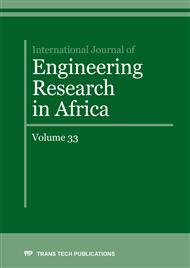[1]
Bhawani Singh and Rajnish K. Goel, 2006. Tunneling in Weak Rocks. Elsevier Geo-Engineering book series volume 5, p.489.
Google Scholar
[2]
R.D. Hammett and E. Hoek, 1981. Design of Large Underground Caverns for Hydroelectric Projects with particular reference to Structurally Controlled failure mechanisms. Paper presented at ASCE Spring Convention, New York, p.16.
Google Scholar
[3]
Evert Hoek and David. F. Wood, 1987. Support in Hard rock Underground Mines. Special Volume 35, 1987, pages 1-6.
Google Scholar
[4]
Dube, A. K. and Singh, B. 1986. Study of Squeezing Pressure Phenomenon in a Tunnel – Part Iand II. Tunneling and Underground Space Technology, 1(1), 35-39 (Part I) and 41-48 (Part II), USA.
DOI: 10.1016/0886-7798(86)90126-4
Google Scholar
[5]
Hoek, E. 2001. Big Tunnels in Hard Rock. The 36th Karl Terzaghi Lecture, J. of Geotechnical and Geo-Environmental Engineering, ASCE, 127(9), 726-740.
Google Scholar
[6]
Wikipedia, 2017. Gilgel Gibe II Power Station. Accessed on 5/10/2017, https: /en. wikipedia. org/wiki/Gilgel_Gibe_II_Power_Station.
Google Scholar
[7]
Tunneltalk, 2017. Collapse of Headrace Tunnel after Grand opening. Accessed on 5/10/2017, https: /www. tunneltalk. com/Gilgel-Gibe-II-Feb10-collapse. php.
Google Scholar
[8]
Eleyas Assefa, Dr. Li Jian Lin, Dr. Costas I. Sachpazis, Dr. Deng Hua Feng, Dr. Sun Xu Shu, and Dr. Anthimos Anastasiadis 2016. Discussion on the Analysis, Prevention and Mitigation Measures of Slope Instability Problems: A case of Ethiopian Railways. Electronic Journal of Geotechnical Engineering, vol. 21. 12, pp.4101-4119.
Google Scholar
[9]
Evert Hoek, 1998. Tunnel support in weak rock. Keynote address, Symposium of Sedimentary Rock Engineering, Taipei, Taiwan, November 20-22, (1998).
Google Scholar
[10]
Wikipedia, 2017. Kombolcha. Accessed on 5/04/2017, https: /en. wikipedia. org/wiki/Kombolcha.
Google Scholar
[11]
YapıMerkezi, 2015. Awash –Kombolcha – Hara Gebeya Railway Project. Geotechnical Report Tunnel T-07 (KM: 261+450 – 261+737) Yapi Merkezi Ethiopian Branch, p.614.
Google Scholar
[12]
E. T. Brown and E. Hoek, 1978. Technical note Trend in relationships between measured insitu stress and depth, int. J. Rock Mech. Min. Sci & Geomech. Abstr. Vol. 15, pp.211-215.
Google Scholar
[13]
Ozgur Satıcı , Bahtiyar Unver , 2015. Assessment of tunnel portal stability at jointed rock mass: A comparative case study. Computers and Geotechnics 64 (2015) 72–82.
DOI: 10.1016/j.compgeo.2014.11.002
Google Scholar
[14]
Evert Hoek, David Wood, and Sandip Shah, 1992. Proceedings of the International ISRM Symposium on Rock Characterization, Chester, UK, September (1992).
Google Scholar
[15]
Rocscience Inc., 2000-9. Rock support interaction and deformation analysis for tunnels in weak rock Tutorial Manual, p.77.
Google Scholar
[16]
Evert Hoek, 1999. Support for Very weak rock associated with Faults and Shear zones. Distinguished lecture for the opening of the International Symposium on Rock Support and Reinforcement Practice in Mining, Kalgoorlie, Australia, 14-19 March, (1999).
DOI: 10.1201/9780203740460-2
Google Scholar
[17]
Evert Hoek and Alan S. Imrie, 1995. Consulting Boards for Large Civil Engineering Projects. Published in Water Power and Dam Construction, Vol. 47, No. 8, pp.33-34, August (1995).
Google Scholar
[18]
Hoek, E. and Brown, E.T. 1980. Underground Excavations in Rock. Instn. Min. Metall., London.
Google Scholar
[19]
Brady, B. H. G. and Brown, E. T. 1993. Rock Mechanics for Underground Mining. London, Chapman Hall, 571 p.
Google Scholar
[20]
Vlachopoulos, N. and Diederichs, M.S. 2009. Improved longitudinal displacement profiles for convergence-confinement analysis of deep tunnels. Rock Mechanics and Rock Engineering, p.16.
DOI: 10.1007/s00603-009-0176-4
Google Scholar
[21]
Carranza-Torres, C. 2004. Elasto-plastic solution of tunnel problems using the generalized form of the Hoek–Brown failure criterion. International Journal of Rock Mechanics and MiningSciences, Proceedings of the ISRM SINOROCK 2004 Symposium, edited by J.A. Hudson and Xia-Ting Feng, Volume 41, Issue 3.
DOI: 10.1016/j.ijrmms.2004.03.111
Google Scholar
[22]
RocscienceInc. 2017. Tutorials. Accessed on 05/01/2017, https: /www. rocscience. com/help/phase2/webhelp/phase2. htm.
Google Scholar
[23]
Owen, G. N., Scholl, R. E. and Brekke, T. L. 1979. Earthquake engineering of tunnels. Proceedings of Rapid Excavation and Tunnelling Conference, Chapter 41, 709-721.
Google Scholar
[24]
Bickel, J. O., Kuesel, T. R. and King, E. H. 1997. Tunnel Engineering Handbook. Chapman & Hall Inc., New York and CBS Publishers, New Delhi, 2nd edition, Chapter 6, 544.
Google Scholar
[25]
Eleyas Assefa, Dr. Li Jian Lin, Dr. Costas I. Sachpazis, Dr. Deng Hua Feng, Dr. Sun Xu Shu, and Dr. Anthimos S. Anastasiadis 2016. Probabilistic Slope Stability Evaluation for the New Railway Embankment in Ethiopia,. Electronic Journal of Geotechnical Engineering, vol. 21. 11, pp.4247-4272.
Google Scholar
[26]
Gavin P. Hayes, Eric S. Jones, Timothy J. Stadler, William D. Barnhart, Daniel E. McNamara, Harley M. Benz, Kevin P. Furlong, and Antonio Villaseñor, 2014. Seismicity of the Earth 1900–2013 East African Rift. U.S. Geological Survey, p.1.
DOI: 10.3133/ofr20101083p
Google Scholar
[27]
Hoek, E. and Marinos, P. 2000. Predicting tunnel squeezing. Tunnels and Tunneling International. Part 1 – November 2000, Part 2 – December (2000).
Google Scholar
[28]
Evert Hoek, Carlos Carranza-Torres, Mark Diederichs, and Brent Corkum, 2008. The 2008 Kersten Lecture Integration of geotechnical and structural design in tunneling. University of Minnesota 56th Annual Geotechnical Engineering Conference to be held in Minneapolis on 29 February (2008).
Google Scholar
[29]
Sachpazis, I.C., (1991). Engineering Geological and Geotechnical mapping methodology for underground excavations. Published in the Bulletin of Mining and Metallurgical Annals, No 75/1991. Greece.
Google Scholar


